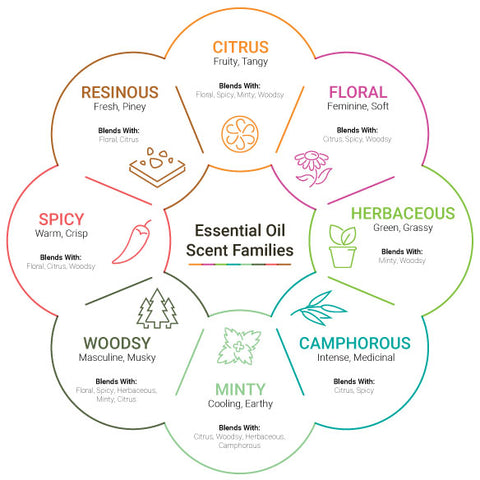Essential Oil Blending Basics
We all have our favorite essential oils, but when it comes to mixing those favorite oils together, some of us can be a little hesitant. Blending essential oils is fun to do, but it also takes some level of practice and skill. Not every oil blends well with another, so how do you know which ones to pick for your next DIY blend?
While blending essential oils can be tricky, we've provided the information, tips, and tricks you need to make the whole process a little easier and a lot more enjoyable! So, what are you waiting for? Grab your favorite essential oils, and let's get started!
What Do You Need To Blend Essential Oils?
Creating your own essential oil blends takes a small amount of preparation and a few specific pieces of equipment. Here's a simple list of what you may need to create your own essential oil blends:
- Your favorite essential oils
- Empty amber glass bottles
- Perfume tester strips (optional)
- Labeling tape or stickers to label your blends
How To Create Your Own Essential Oil Blends
New to blending essential oils? No problem! Blending essential oils is an art and science, but anyone can do it! All it takes is a little help and some practice. And who knows—you could be a natural!
To get started on your next DIY essential oil blend, just follow the steps outlined below!
Choose Your Oils
One of the best parts about creating your own essential oil blends is that you get to pick which oils you want to use! You can pick the oils for your blend in a few different ways:
- Choose oils that smell the best for you
- Choose oils that you believe will create a pleasant blend together
- Choose oils that offer the therapeutic benefits you are looking for
If you are choosing oils that have similar benefits, you can check out the RMO Collections for a detailed list of oils that can give you the results you are looking for. If you're trying to find a group of oils that will smell good together, it is best to start with identifying each oil's scent family.
Every single oil is part of a scent family, meaning that it has a dominant scent that you can place in a category. Scent families include floral, citrus, spicy, and several others. When blending essential oils, it is best to blend oils that are either from the same scent family or their complementary scent families. When picking the oils for your blend, you can smell each oil individually and make note of the scent family it belongs to. Then, you can have a better idea of which oils may blend well together. Keep in mind that there are no rights or wrongs with this; placing oils in their scent families is based on preference and how the oils smell to you.
Not sure which scent families blend well together? Check out this simple reference chart:

Separate Oils By Their Notes
If you've never heard an oil's scent referred to as a note, this may sound a bit confusing. But don't fret! Essential oils don't have a hidden musical talent. An oil's note refers to its individual aromatic compounds and its evaporation rate. There are three types of notes for an essential oil: top, middle, and base.
- Top Note: This includes oils that have a low molecular weight, meaning that they evaporate faster. These oils are the first that you smell when you inhale a blend. Once this oil's aroma evaporates, the other oils' aromas can become more prominent.
- Middle Note: These oils do not evaporate as quickly as top note oils, but faster than base note oils. Oils with a middle note evaporation rate create a bridge between the top and base notes, bringing greater balance and harmony to your blend.
- Base Note: These oils have the heaviest molecular weight, meaning that they are the last to evaporate. Oils with base notes are often very faint when you first inhale the blend but grow stronger after some time. Base notes help 'hold down' the rest of the blend, making the aroma as a whole longer-lasting.
Now that you have a better idea of what an oil's note is, it's time to determine the notes of each oil you want to potentially use in your blend. You can do that in a couple of different ways. First, you can refer to this handy chart that lists out some of the most common oils' notes:

If you prefer to determine your oils' notes on your own, or if your oil isn't listed, you can do a simple organoleptic test with the following steps. Be sure to have a notebook handy!
- Place a drop of oil on a perfume testing strip.
- Slowly draw the strip up to your nose, creating circles in the air about a foot away so that you can get an even breath of the oil's aroma.
- Take note of how far away the strip is before you start smelling the oil's aroma.
- Take some quick breaths, then a few slow and deep ones.
- Describe how the oil makes you feel. What thoughts and sensations do you experience when you smell the aroma?
- Put down the tester strip, and step away for 10 minutes. Get some fresh air or smell some coffee grinds to clear your airways.
- Return to the tester strip and smell the aroma again. Has the aroma gotten lighter, or is it still heavy? Did the aroma last long?
- Repeat steps 6 and 7 two more times so that you smell the oil's aroma a total of three times. Take note of how strong the aroma is each time you come back.
- After you've smelled the aroma for the third time, try to place the oil in its appropriate note. Top notes will be strong at first but fade over time. Middle notes will be slightly fainter at first, and the strongest in the middle of the test. Base notes will be faint at first and stronger at the end.
Decide Which Oils To Use In Your Blend
Now that you know each oil's scent family and note, it's time to pick the oils for your blend. A good way to do this is to make a list of the oils in each scent family, and mark whether each oil is a top, middle, or base note. Then, you can easily see all of the information together.
A good rule of thumb for blending oil is to pick three oils: one top note, one middle note, and one base note. As you become more familiar with making your own blends, you can branch out and add more oils, but three is a good starting point. These three oils can be from the same scent family, or from complementary ones. Take a look through your list and pick the oils you want to use. Odds are you will have a variety of combinations to pick from. Simply choose the one you feel most drawn to, or make several blends!
Creating Your Own Essential Oil Blend
Now that you have your 3-oil combinations picked out, it's time to start blending! When blending essential oils, there are several points to keep in mind regarding how much of each oil you need:
- If an oil has a particularly strong aroma, you do not want to blend equal parts of that oil, as it will overpower the other aromas.
- A good rule of thumb is to base your formula off of 100 drops to determine the percentage of each oil in your blend. 100 drops will give you 1 tsp of blend, which you can dilute in 8oz of a carrier oil for a 2% dilution rate.
- For example: With 100 drops, 10 drops of an oil will be 10%, 8 drops will be 8%, and 2 drops is 2%. If you only a total of 20 drops, you will need to add 1.6oz of carrier oils for a 2% dilution rate.
- When formulating your blend, be sure to stop occasionally and inhale the aroma. This can help lead you to decide just how much of each oil you want.
- Once your blend is finished, let it rest for a day so that the oils can mix together properly. After a day, smell the blend again and make any adjustments you want.
Voila! Now that all of your oils are mixed together in a tiny bottle, you've created your very own essential oil blend! Blending essential oils offers a chance to be creative and adventurous. Don't be afraid to explore different combinations. There will be some blends you end up not liking, and there will be some you absolutely love! Whatever the outcome, have fun in the process, and enjoy experiencing the benefits of the essential oils in your collection in a new way!
Did you create a blend that you just love? We want to know! Share your favorite DIY essential oil blends with us in the comments below!

